Tribes Aerial Assault Preview
We take the PS2 version of Tribes for an extended run.
Last week, Sierra brought by a playable version of Tribes Aerial Assault, along with a set of broadband-adaptor-equipped PlayStation 2 units. We had the chance to play the game online with fellow editors, as well as beta testers and Sierra employees, as our opponents back in Seattle. We came away much impressed by how well the game handled from a technical standpoint and by just how much it managed to re-create the high-flying madness that Tribes 2 on the PC is known for. Since then, we've had a lot of time to mess around with the game on our own, albeit offline, and have managed to put together all the information regarding its various play modes and impressive set of options.
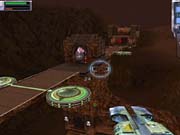
For those unfamiliar with the series, Tribes is known as the first FPS game to effectively use the Z-axis in 3D space--but the second if you count Interplay's classic Descent series. It did this by strapping jetpacks to the backs of combatants, granting them the ability to blast off powerful bursts up in the air. This brought to the game a new layer of strategy previously untapped by other first-person shooters and earned the game a dedicated following as a result. Tribes 2 further refined the formula, adding new items and vehicles and generally tightening up the game's pace. It's directly on this version that Tribes Aerial Assault is based. The game is essentially a pared-down version of Tribes 2, whose maps have been made more manageable in the context of the smaller head count that it will allow for. Specifically, the PC game allowed for upward of 60 players in a multiplayer game at once--Aerial Assault will allow for 16. While it may seem like a drastic cut, its actual effect on the game doesn't feel all that serious. The environments will still feel quite populated, and the game's unique mechanics make the time you may spend traversing space in search of a fight that much more bearable.
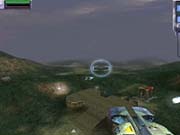
As you'd imagine, much had to be done to fit a game--with controls as complex as Tribes 2's--to a gamepad. And given just how much functionality had to be crammed on the DualShock controller, Sierra has done an admirable job. If you've played any recent console FPS, then the basic controls will be second nature to you--just like with Halo, in which you move around with the left analog stick and control your view with the right. Upward movements, in the form of jetpack thrusts, are accomplished with the R1 button. You have an energy meter that dictates just how much thrust you can muster at any given time, which you'll have to pay close attention to--because if you can't counterthrust during your descent, your fall will be speedier than healthy, and you'll suffer immensely. Your regular jump, conversely, is mapped to the L1 button. Given the power of your thrusters, you'd think that the jump is of secondary importance, but the opposite is actually true. The act of "skiing" is one of the game's more unique mechanics, and it is accomplished by holding down the jump button while going downhill. Doing so lets you gain an insane amount of momentum and serves to counterbalance thrusting when moving through rough terrain.
Splash Damage
Compared with other first-person shooters, the combat in Tribes can seem downright methodical. It isn't so much about reflexes as it is about precision and timing, especially when you take into account its high-flying game dynamics. As logic would dictate, hitting airborne targets is harder than hitting land-bound ones. As such, the most distinctive (and often effective) weapons in the game make the assumption that you'll be shooting them from the air.
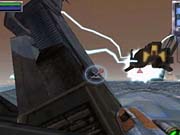
The control scheme that Sierra has designed works quite well with the game's unique dynamics, successfully making some of the more arcane tactics in the game much more accessible. On the PS2 pad, you'll fire your weapons with the L2 trigger, and you'll cycle through your inventory with the circle button. The square button is charged with your lock-on feature, and don't worry--it isn't as cheesy as it sounds. The designers realized that dealing with targeting, while simultaneously managing an ascension or fall and avoiding enemy attacks, might be just a bit much for newbies to handle. The lock-on feature was designed to take some of the edge off this, and it does so quite successfully. Essentially, if your target is close enough to a potential enemy, hitting the square button will automatically lock on to it. If you're using certain weapons, it'll "suggest" a spot for you to shoot at instead, the idea being that your enemy will arrive at the said point at the same time that your projectile will. It all works quite well in practice, and once your skills are up to snuff, you have the option of turning it off at will. You'll also have access to various types of grenades, which you deploy with the triangle button. These include basic explosive grenades that do splash damage; concussive grenades, which are used to expel enemies from an area; flare grenades, which are used to mark space and fool missiles; and burrowing mines, which detonate whenever something comes within a certain range of them.
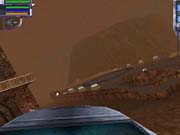
There are three basic equipment profiles that you'll get to choose from when playing Tribes Aerial Assault, and these determine just how well protected, well armed, and mobile you are. The first is light armor, which packs the fewest weapons (only three), offers the least protection from attacks, and is the less versatile of the three in terms of deploying the various gadgets at your disposal. On the plus side, light armor lets you pilot any of the game's vehicles and offers the highest amount of mobility. Next up is medium armor, which lets you carry up to four weapons and select any of them, save for the fusion mortar, which is the game's heaviest gun. It can pilot all but the lightest vehicle in the game and has access to all the special gadgets. Last up is the heavy armor, which makes you a veritable walking tank. You won't be able to move too effectively as a result, but you'll certainly be well armed. You can carry up to five weapons and wield the heaviest guns that the game has to offer. You'll also be able to use any and all gadgets in the game, but at a fair price--you won't be able to pilot any vehicles. You aren't stuck with any particular profile during the game, though, since swapping between the three is as easy as accessing special inventory terminals located within your team's base. Once in one, you can change into whatever armor you want, complete with the weapon- and equipment sets you preselect in your player profile.
Heavy Gear
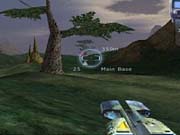
In Tribes Aerial Assault, the equipment that you use is just as important as the strategies that you and your team will adopt. There are a whole bunch of options available to you in this regard, and when taken as a whole, they give you the power to essentially tailor the game to whatever style you find most enjoyable. If you prefer to play a defending role, for instance, you'll stick to heavy armor and tend to the base, blasting incoming enemies with heat-seeking missiles and planting turrets around your protected ground. If you're more of a striker, you'll adopt the light profile and either infiltrate the base on foot or in the cockpit of a fast-attack fighter. There are eight weapons in the game, each with a very specialized role and unique mechanics. These include the blaster, which is the standard side arm with essentially unlimited ammo; the chaingun, which can easily chew up enemies at close ranges; the laser rifle, which serves as a high-speed sniper weapon; the spinfusor, which is arguably the definitive Tribes weapon, with its emphasis on splash damage; the grenade launcher, which hurls the explosive projectiles for considerable distances; the fusion mortar, which hurls gigantic, explosive bolts that do lots of splash damage; the missile launcher, whose shells are heat-seeking to boot; and the plasma rifle, which shoots ultradamaging plasma bolts that explode on contact. You'll also have a variety of defensive "packs" at your disposal, and their uses are myriad. Some allow you repair damage to a friendly player or structure (like a turret), while others let you switch the output types on friendly turrets. Still others let you create inventory stations outside of your base or set up remote turrets that will attack incoming enemies. The number of options is simply staggering, and, as mentioned before, they do a whole lot in letting you custom-tailor the experience to your liking.
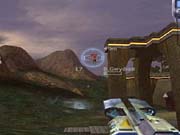
As Tribes 2 was among the best-looking PC games at the time of its launch, there is natural concern as to how the PS2 version of the game turns out. And in truth, the game manages to look admirable, compared with other FPS games on the system, and this is especially impressive given just how big some of the playfields are. Still, there is quite a bit more fogging to be found on many of the maps, which, while it may feel atmospheric at times, still feels like it obscures more than you might like. The texture quality actually looks quite decent, with levels of detail increasing as cover ground and approach structures. The look overall is quite solid, and the frame rate is very consistent, even in the thickest of frays. During online play, the frame rate remained constant, though there was a bit of "ghosting" going on, which is most likely a consequence of server performance rather than something graphics-related.
Tribes Aerial Assault will boast all the requisite play modes for a game of its type, including capture the flag, deathmatch, and team deathmatch. It will also include two that are a bit more unique: capture-and-hold and hunters. The former has you and your team capturing specific areas on the maps and defending for as long as possible, and the latter is a variation of the standard deathmatch, with downed enemies dropping flags that can be "redeemed" at set spots on the maps for exponentially increasing point counts. In all, the game looks like it's coming together quite nicely, and it should provide the series' signature gameplay experience in an engaging, faithful form come its October release. We'll keep you posted on any updates.
Got a news tip or want to contact us directly? Email news@gamespot.com
Join the conversation